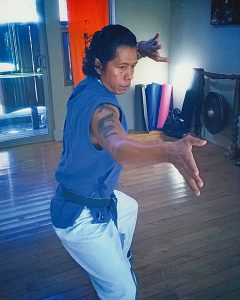Power to Destroy is now the Power to Heal
By Noel Smith

Led by Pol Pot, the new regime modeled itself on Maoist China during the Great Leap Forward evacuating the cities and sending the entire population on forced marches to rural work projects. An estimate as to how many people were killed by the Khmer Rouge regime is two million (about a quarter of the population). (See the 1984 Academy Award-winning film “The Killing Fields”). Hundreds of thousands of Cambodians fled across the border into neighboring Thailand.
Pat was 8 years old when he found himself a prisoner in a children’s forced labor camp. For four years he somehow survived the brutality and the hardships while many of those around him did not. They were starved, ridden with diseases and parasites, and worked to death. During that time, he lost his mother, brother, and his grandfather who Pat described as having a “Strong will.” He did have siblings that survived, but they did not find each other until many years later.
“I never expected to survive, I knew I was going to die,” he said. One of the soldiers who brought him back to the camp befriended him. While having to treat Pat cruelly when around the other guards, they were able to surreptitiously remain friends, which enabled Pat to survive.
Pat and the guard finally left the camp together but went their own ways with Pat going to Thailand where hundreds of thousands of Cambodians were in refugee camps. There in Thailand, because of his terrible physical condition, he was cared for by Doctors Without Boarders and began to learn English. A couple from Belgium he befriended adopted him. He arrived with his new family at the age of 12 in Belgium on January 13, 1980. According to Pat, “I’d never felt cold like that before.”
Having regained his health and now powered by the anger he felt about all the terrible things he had survived, Pat became a student of the martial arts. He also had a warrior ancestry. His Chinese great-grandfather had been a general in the Cambodian King’s army and Pat had begun to learn martial arts from his father and grandfather before their world fell apart.
In Belgium, a country that takes the martial arts seriously, Pat became a national champion in his teens. At the age of 21, he went to live in Japan for two years. There Pat studied kyokushinkai karate, a full-contact karate training considered by some to be the most violent of the martial arts. Throughout the ’80s, Pat became proficient at kung fu Thai boxing, and several other forms of fighting.
Finally, after all the years of fighting and physical violence, his anger was abating. Pat began to realize that the same discipline that fighting required of the human body and mind could also be used to heal. “I began with a little love which becomes a big love for other people.”
Today Pat’s power to hurt and destroy has become the power to heal and renew. No longer is it the power of anger that drives him, but as a sensei (teacher, master, elder) it is the power of love for his fellow man expressed as a need to help others to heal.
Howard Sherer (62) was diagnosed with Parkinson’s disease five years ago. Parkinson’s affects over one million Americans, and is the most common neurodegenerative disease after Alzheimer’s. Symptoms include tremors, stiffness of the limbs and trunk, and impaired balance and coordination. Howard began working with Pat two years ago, both privately and in class four times a week.
“Over the past two years my symptoms have decreased,” said Howard, “I can do things I couldn’t when I started with Pat.” Examples include more flexibility, wider range of motion, straighter posture, easier movement and walking without “freezing.”
Sherer said, “For years my first step has been difficult, I had a hard time just starting. Now it’s not as difficult and sometimes not at all. I’ve learned to bring my consciousness into the movement.” When leaving a stadium or auditorium Sherer used to have to wait for everyone to leave, “Because when I’d stop, I couldn’t start again. Now I’m now able to walk in crowds.”
This is Pat’s gift and his mission; substituting peace and healing for violence and anger using what is called “Chi Power Arts.” It teaches how to meld body and mind so that they are in harmony. Pat believes that to overcome sickness, disease, depression, low self esteem, arrogance, bad attitude, selfishness, and physical danger requires the alignment of empowerment, healing and strength through the power of balance and integration.
•••
For more information on Chi Power Arts visit chipowerarts.com.